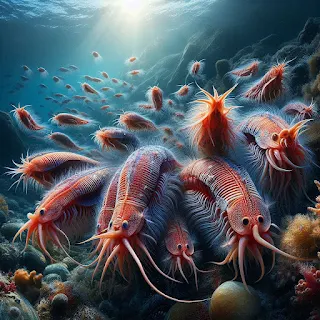 |
| Artistic interpretation of Hemichordates |
Introduction
The phylum Hemichordata (Kingdom Animalia) is a small but significant group of marine organisms that share characteristics with both chordates and non-chordates. These animals are primarily known for their worm-like appearance and unique body structure, which includes features such as a stomochord and a three-part body division. Hemichordates play a crucial role in understanding the evolutionary link between invertebrates and vertebrates.
Key Characteristics
Habitat: Marine environments, from shallow waters to deep seas
Body Organization: Organ-system level of organization
Symmetry: Bilaterally symmetrical
Layers: Triploblastic
Body Cavity: Coelomate
Body Structure
- Division: The body is divided into three regions: proboscis, collar, and trunk
- Stomochord: A flexible, hollow tube found in the proboscis, previously thought to be homologous to the notochord of chordates
- Nervous System: Consists of a dorsal nerve cord and a ventral nerve cord.
Digestive System
- Complete Digestive Tract: With a mouth, esophagus, pharynx, intestine, and anus.
- Filter Feeding: Many hemichordates are filter feeders, using their pharyngeal slits to capture food particles from the water.
Respiratory and Circulatory Systems
- Gill Slits: Pharyngeal gill slits are used for respiration.
- Circulatory System: Open type with a heart and blood vessels.
Reproduction
- Sexes: Usually dioecious (separate sexes).
- Fertilization: External.
- Development: Indirect, with a larval stage known as the tornaria larva.
Examples
- Balanoglossus (Acorn Worm): Known for its burrowing behavior and distinctive proboscis.
- Saccoglossus: Another acorn worm species, similar in structure and behavior to Balanoglossus.
Detailed Examples
Balanoglossus (Acorn Worm)
Habitat
Balanoglossus, commonly known as the acorn worm, is found in marine environments, typically in sandy or muddy substrates along the seashore.
Physical Characteristics
- Proboscis: A distinctive, acorn-shaped structure used for burrowing and feeding.
- Collar: Located behind the proboscis, containing the mouth.
- Trunk: The longest part of the body, housing the digestive and reproductive organs.
Body Structure
- Stomochord: Provides support and is involved in feeding.
- Gill Slits: Numerous pharyngeal slits for respiration.
Feeding
- Filter Feeding: Uses cilia on the proboscis to direct food particles into the mouth.
- Diet: Consists mainly of detritus and microorganisms.
Reproduction
- Sexual Reproduction: Separate sexes with external fertilization.
- Larval Stage: Tornaria larvae, which are free-swimming and undergo metamorphosis to become adults.
Saccoglossus
Habitat
Saccoglossus species are found in similar marine environments as Balanoglossus, often burrowing in sandy or muddy substrates.
Physical Characteristics
- Similar to Balanoglossus: Possesses a proboscis, collar, and trunk.
- Size: Generally smaller than Balanoglossus.
Body Structure
- Stomochord and Gill Slits: Similar functions as in Balanoglossus.
Feeding
- Filter Feeding: Uses a similar mechanism to capture food particles.
Reproduction
- Sexual Reproduction: Dioecious with external fertilization.
- Larval Stage: Undergoes a tornaria larval stage before metamorphosis.
FAQs
What type of habitat do hemichordates occupy?
Hemichordates are found in marine environments, from shallow waters to deep seas.
What kind of body symmetry do hemichordates exhibit?
Hemichordates exhibit bilateral symmetry.
How is the body of hemichordates divided?
The body of hemichordates is divided into three regions: proboscis, collar, and trunk.
What is the stomochord in hemichordates?
The stomochord is a flexible, hollow tube found in the proboscis, previously thought to be homologous to the notochord of chordates.
How do hemichordates respire?
Hemichordates respire through pharyngeal gill slits.
What type of circulatory system do hemichordates have?
Hemichordates have an open circulatory system with a heart and blood vessels.
Are hemichordates dioecious or monoecious?
Hemichordates are usually dioecious, meaning they have separate sexes.
What type of fertilization is seen in hemichordates?
Hemichordates typically have external fertilization.
What kind of development is observed in hemichordates?
Hemichordates undergo indirect development with a larval stage known as the tornaria larva.
Can you name some examples of hemichordates?
Examples of hemichordates include Balanoglossus (Acorn Worm) and Saccoglossus.
Multiple-Choice Questions (MCQs)
1. What type of symmetry do hemichordates exhibit?
a) Radial
b) Bilateral
c) Asymmetrical
d) None of the above
2. What is the main function of the stomochord in hemichordates?
a) Locomotion
b) Support and feeding
c) Reproduction
d) Excretion
3. Which of the following is absent in hemichordates?
a) Digestive system
b) Circulatory system
c) Excretory system
d) Respiratory system
4. Where is the mouth located in hemichordates?
a) Dorsal side
b) Ventral side
c) Lateral side
d) Posterior side
5. Hemichordates respire
a) Through lungs
b) Through gills
c) Through pharyngeal slits
d) Through skin
6. What type of reproduction is observed in hemichordates?
a) Asexual
b) Sexual
c) Both a and b
d) None of the above
7. What type of development is seen in hemichordates?
a) Direct
b) Indirect
c) Both a and b
d) None of the above
8. What type of skeleton do hemichordates have?
a) Exoskeleton
b) Endoskeleton
c) Hydrostatic skeleton
d) None of the above
9. How is fertilization typically carried out in hemichordates?
a) Internally
b) Externally
c) Both a and b
d) None of the above
10. Which of the following is an example of a hemichordate?
a) Balanoglossus
b) Hydra
c) Fasciola
d) Taenia
Answers to MCQs
- b) Bilateral
- b) Support and feeding
- c) Excretory system
- b) Ventral side
- c) Through pharyngeal slits
- b) Sexual
- b) Indirect
- b) Endoskeleton
- b) Externally
- a) Balanoglossus





.png)
.png)
.png)


0 Comments